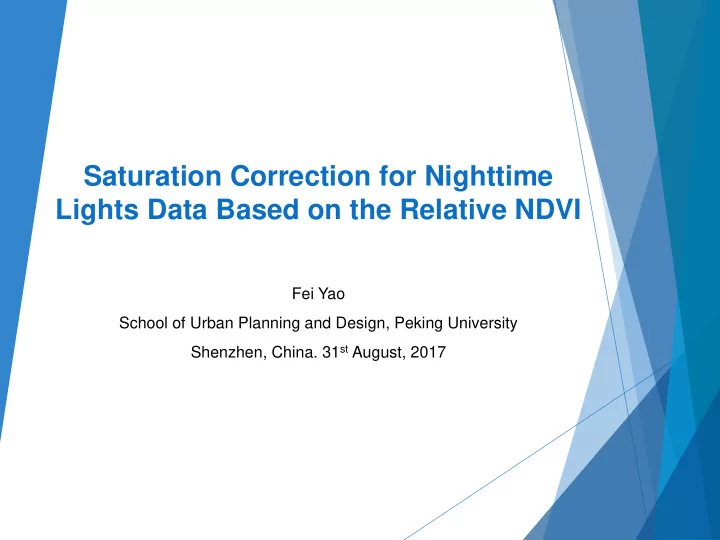

Saturation Correction for Nighttime Lights Data Based on the Relative NDVI Fei Yao School of Urban Planning and Design, Peking University Shenzhen, China. 31 st August, 2017
DMSP-OLS Defense Meteorological Satellite Program Operational Linescan System Mainly used for monitoring clouds. Later it was found to be capable of monitoring nighttime light for the Earth surface, which is a beautiful accident!
DMSP-OLS Data Download URL: https://ngdc.noaa.gov/eog/dmsp.html Global DMSP-OLS Nighttime Lights Time Series 1992 - 2013 (Version 4) F1?YYYY.v4b_web.cf_cvg.tif F1?YYYY.v4b_web.avg_vis.tif F1?YYYY.v4b_web.stable_lights.avg_vis.tif F1?YYYY.v4b.avg_lights_x_pct.tif Global Radiance Calibrated Products F1?(-F1?)_YYYYMMDD-YYYYMMDD_rad_v4.avg_vis.tif F1?(-F1?)_YYYYMMDD-YYYYMMDD_rad_v4.cf_cvg.tif
Comparison between SNL and RCNL data Stable nighttime light data Radiance calibrated nighttime light data 101 minute, sun-synthronous near-polar 101 minute, sun-synthronous near-polar Orbit orbit at an altitude of 830 km orbit at an altitude of 830 km ≈3000 km ≈3000 km Swath ≈19:30 (local time) ≈19:30 (local time) Transit time Value Grey value Relative radiance value 30-arc- second (≈1 km) 30-arc- second (≈1 km) Spatial resolution Radiance calibration No Yes Saturation Exist in urban center No Composit products Annual Irregular Time series 1992-2013 1996/1999/2000/2002/2004/2006/2010 SNL data needs saturation correction. Both SNL data and RCNL data need intercalibration when conducting time series analysis.
Four kinds of ways to correct saturation Methods Representative work Assessment Utilizing dynamic staellite gain settings Elvidge et al., 1999; Ziskin et al., 2010 Best, costly, limited images produced. Regional regression models Hara et al., 2004; Letu et al., 2010 Simple but not at the pixel scale Using the RCNL data to correct Letu et al., 2012 Too many assumptions Utilizing other kinds of datasets to correct Cao et al., 2009; Lu et al., 2008 Quite inspiring and promising Saturation correction for nighttime light data based on the relative NDVI
Flowchart Identifying saturated areas Calculating RNDVI Saturation correction Regression formula establishment
Identifying saturated areas Linear regression test between SNL and RCNL data in year 2006.
Identifying saturated areas Linear regression test between SNL and RCNL data in year 2006.
Identifying saturated areas Examine the distribution rules of the DNs of the SNL and RCNL data.
Identifying saturated areas Examine the distribution rules of the DNs of the SNL and RCNL data.
Identifying saturated areas Unsaturated pixels if DN<50 Slightly saturated pixels if 50 ≤ DN ≤ 55 Saturated pixels if DN>55, which were corrected in this work.
Calculating RNDVI NDVI=0.004*value-0.1 𝑜 𝑂𝐸𝑊𝐽 𝑢 real NDVI= 𝑛𝑏𝑦 𝑢=1 RNDVI=real NDVI-interpolated NDVI
Regression formula establishment The quadratic function depicts the relationship best RNDVI is a better indicator than the real NDVI R 2 R 2 Coefficient Coefficient RNDVI 0.42 -534.56 NDVI 0.14 77.89 RNDVI 2 NDVI 2 0.48 1793.04 0.08 90.90 RNDVI 4 NDVI 4 0.29 7554.81 0.04 120.68
Regression formula establishment RNDVI might also suffer a “saturation problem” when its value is smaller than -0.4, which should be noted.
Saturation Correction Good results
Saturation Correction Qualitative evaluation of results
Saturation Correction Qualitative evaluation of results
Saturation Correction Quantitative evaluation of results Relationship with the 2006 RCNL image 2006 SNLImage Corrected Image R 2 0.53 0.65 RMSE 30.53 26.39 Relationship with the GDP (Correlation coefficient 0.8461 and 0.8626 for the 2006 SNL image and corrected image)
Discussion and conclusions Different strategies for different degree of saturation The effectiveness and deficiency of RNDVI Extend the proposed method to other regions and other years
Thank you Q&A
Recommend
More recommend